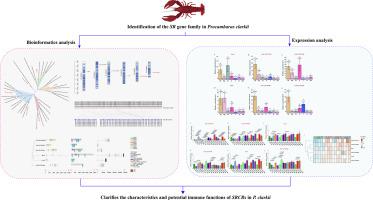克氏原螯虾SR基因家族的全基因组鉴定及其对副溶血性弧菌非致死性热休克的表达响应
IF 2.2
2区 生物学
Q4 BIOCHEMISTRY & MOLECULAR BIOLOGY
Comparative Biochemistry and Physiology D-Genomics & Proteomics
Pub Date : 2025-09-17
DOI:10.1016/j.cbd.2025.101638
引用次数: 0
摘要
清道夫受体(Scavenger receptor, SRs)是免疫系统中重要的模式识别受体,其中SRCR结构域成员(SRCRs)在免疫系统中起着至关重要的作用。本研究通过全基因组筛选,系统分析了克氏原螯虾SRCR基因,鉴定出6个家族成员。这些基因表现出不同的分子特征,编码的蛋白在长度(535-2970 aa)、分子量(60.13-333.02 kDa)和稳定性(大多不稳定)上各不相同。结构分析表明,Loxl2基因结构多样,SRCR结构域保守,在6条染色体上分布均匀,与中华绒螯蟹具有进化保守性。qPCR组织特异性表达分析显示,在血细胞(免疫相关)、鳃(Loxl2,病原体应答)、肝胰腺(代谢/解毒)和肠道(LOC123759426,肠道免疫)中均有高表达。在非致死性热休克(NLHS)和细菌攻击后,LOC123770744和LOC123759426的表达发生了显著变化,表明其参与了应激反应,而其他基因则表现出不同程度的差异表达。本研究阐明了SRCRs在克氏疟原虫中的特性及其潜在的免疫作用。本文章由计算机程序翻译,如有差异,请以英文原文为准。

Genome-wide identification of the SR gene family in Procambarus clarkii and their expression responses to Vibrio parahaemolyticus under non-lethal heat shock
Scavenger receptors (SRs) are key pattern-recognition receptors in immunity, with SRCR domain-containing members (SRCRs) playing vital roles. This study systematically analyzed SRCR genes in Procambarus clarkii via genome-wide screening and identified six family members. These genes exhibit diverse molecular characteristics, with their encoded proteins varying in length (535–2970 aa), molecular weight (60.13–333.02 kDa), and stability (mostly unstable). Structural analysis revealed diverse gene structures, conserved SRCR domains, and an even distribution across six chromosomes, with Loxl2 showing evolutionary conservation with Eriocheir sinensis. Tissue-specific expression analysis by qPCR indicated high expression in hemocytes (immune relevance), gills (Loxl2, pathogen response), hepatopancreas (metabolism/detoxification), and intestine (LOC123759426, intestinal immunity). After non-lethal heat shock (NLHS) and bacterial challenge, LOC123770744 and LOC123759426 showed significant expression changes, indicating roles in stress responses, while the other genes exhibited varying degrees of differential expression. This study clarifies the characteristics and potential immune roles of SRCRs in P. clarkii.
求助全文
通过发布文献求助,成功后即可免费获取论文全文。
去求助
来源期刊
CiteScore
5.10
自引率
3.30%
发文量
69
审稿时长
33 days
期刊介绍:
Comparative Biochemistry & Physiology (CBP) publishes papers in comparative, environmental and evolutionary physiology.
Part D: Genomics and Proteomics (CBPD), focuses on “omics” approaches to physiology, including comparative and functional genomics, metagenomics, transcriptomics, proteomics, metabolomics, and lipidomics. Most studies employ “omics” and/or system biology to test specific hypotheses about molecular and biochemical mechanisms underlying physiological responses to the environment. We encourage papers that address fundamental questions in comparative physiology and biochemistry rather than studies with a focus that is purely technical, methodological or descriptive in nature.

 求助内容:
求助内容: 应助结果提醒方式:
应助结果提醒方式:


